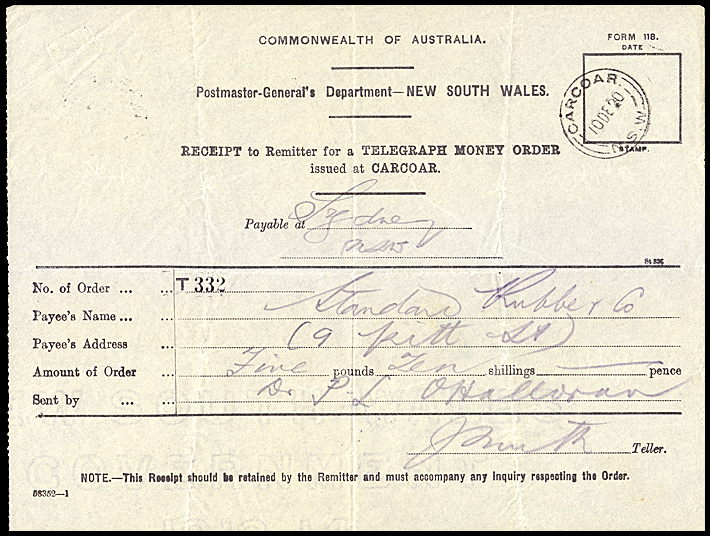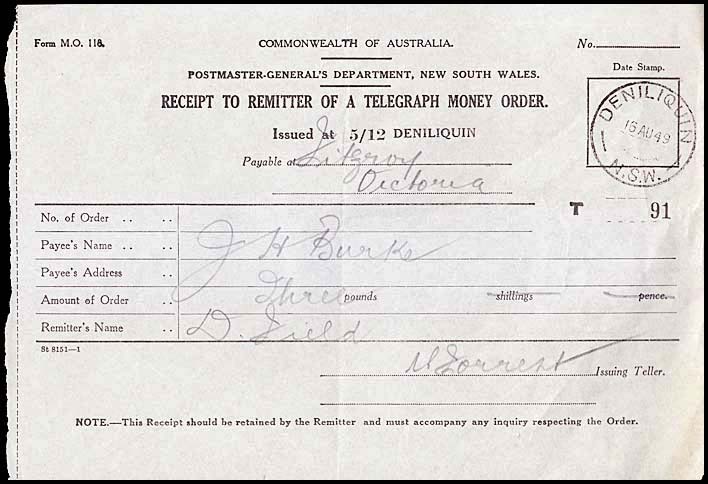Telegraphic Money Orders.
- Australia 1901-1988
- New South Wales
- Queensland
- South Australia
- Tasmania
- Victoria
- Western Australia
- International
- Special aspects
Telegraph Money Orders were a form of transmitting money using telegraphic communication rather than the postal system. It involved sending a notification to a designated Telegraph Office and, at the same time, sending a telegram to the named recipient notifying them of the transfer.
First suggestions in New South Wales:
In the Legislative Assembly on 22 September 1859, the Colonial Secretary (Mr. Cowper) noted that the Report of the Postmaster-General for 1856 (contained) a very long and rather elaborate paper upon the subject on the Money-Order system. In the 1858 Report, the Postmaster-General had stated that "it would be impossible to carry out a money order system while the duties of the Post Office were carried on in the present building. He (Mr. Cowper) had had frequent conversations with Major Christie in reference to the desirability of introducing a money order system at the earliest possible period. Captain Martindale had for some time past been in communication with him (Mr. Cowper) for the purpose of bringing into operation a money-order system in connection with the telegraph. That system was nearly completed for transmitting by telegraph money orders not exceeding £10. Until a new building was erected, he thought a money-order system in connection with the Post Office must be deferred".
The Telegraph Money Order system began in New South Wales in 1860 but, as is shown by the report in The Sydney Morning Herald of 13 February 1860, there was a delay:
"We are still unable to report the commencement of the money order system in connexion with the electric telegraph, which has for many months been promised to the public. All the details have been long since decided on and the only obstacle to the establishment of this most convenient mode of remittance is the want of the authority from thc Legislature, the opening of the system involving a trifling expendíture. The required amount is amongst the Estimates for this year but these have not yet been commenced and it will probably be several weeks before this item is passed".
by the following announcement in the Maitland Mercury & Hunter River Advertiser of 26 June 1860 - which was typical of those carried in other newspapers:
ELECTRIC TELEGRAPH - MONEY ORDER BRANCH.
Department of Public Works,
Sydney, 21st June, 1860.
His Excellency the Governor General, with the advice of the Executive Council, has been pleased to approve of the establishment of a money order branch of the New South Wales Electric Telegraph Department.
On and after 1st July next, money orders can be transmitted by electric telegraph between the under-mentioned stations, and at the rates, and under the regulations following:
Stations: Sydney, Gundagai, West Maitland, Goulburn, Albury, Newcastle, Yass, Windsor, Bathurst.
- Each money order to be limited to £5.
- No person to obtain, on one day, more than two orders in favor of the same payee.
- The charge or premium to be 6d. (sixpence) for any sum not exceeding £2 (two pounds), and 1s. (one shilling) above £2 (two pounds) and not exceeding £5 (five pounds), in addition to the minimum charge for transmission of a message between any two of the above-named stations.
- All money orders will be delivered to the payees as telegrams, and the money due will be payable on demand at the telegraph offices, by cheque on the Bank of New South Wales, or other most convenient bank, should there be no local branch of the Bank of New South Wales.
- Parties transmitting money orders will be informed by telegraph (without charge), as soon as their orders have been paid. Receipts will, in all cases, be given for money deposited, and committed for money paid.
NB - It is proposed to extend these arrangements hereafter to the sister colonies, and to such other station within New South Wales as may appear advisable.
The Regulations for Telegraphic Money Orders in N.S.W. are included elsewhere.
It was not long before rates were reduced as the system had been well supported in the first few months. These reductions came into effect on 17 September 1860 with the main changes being as follows:
- Money Orders to be limited to £20 in favour of the same payee on the same day.
- the charge or premium to be 6d. (sixpence) for any sum not exceeding £10 (ten pounds), and 1s. (one shilling) above £10 (ten pounds) and not exceeding £20 (twenty pounds), in addition to the minimum charge for transmission of a message between any two of the above-named stations.
The system did not prove able to pay its way and so, in January 1863, it was transferred to the Postal Money Order Branch. Of course, telegrams advising of payments were still sent at the rate of the minimum charge for a message, according to the wishes of the sender.
The post-office telegraphic money order system between the colonies of New South Wales and Victoria was introduced on the 1st May 1875. Arrangements for the telegraphic money order system to be extended from NSW to South Australia and to Queensland were completed in June 1875.
Examples of Money Order Receipt forms for New South Wales.
 |
NI-MO-1
Carcoar to Sydney Receipt for the transmission of £5/10/-. Characteristics:
Costs for NSW Colonial Money Order - see Goulburn Evening Penny Post 29 August 1893. |
 |
AW-MO-2.
To Fitzroy, Vic from Deniliquin. Characteristics:
|